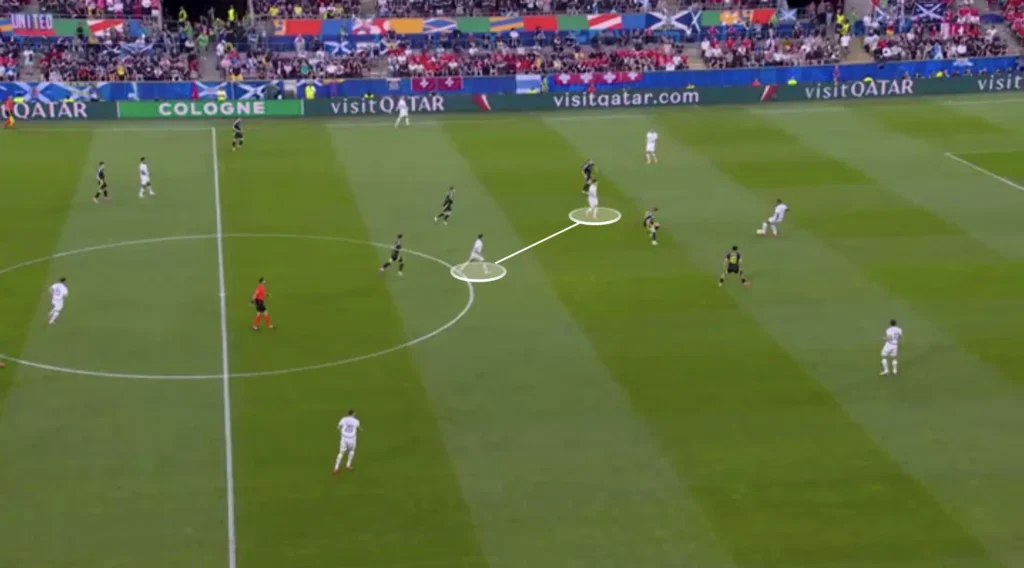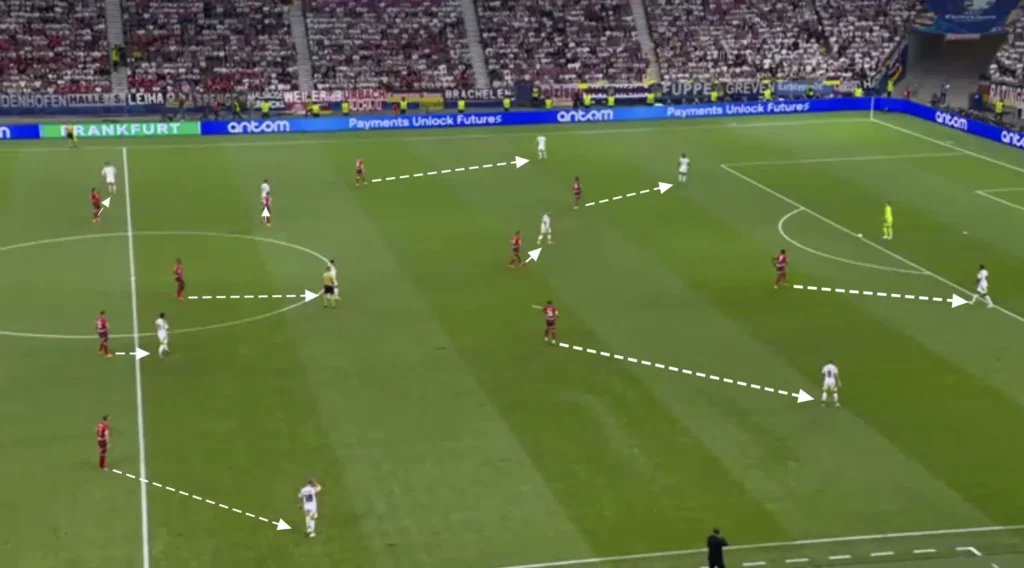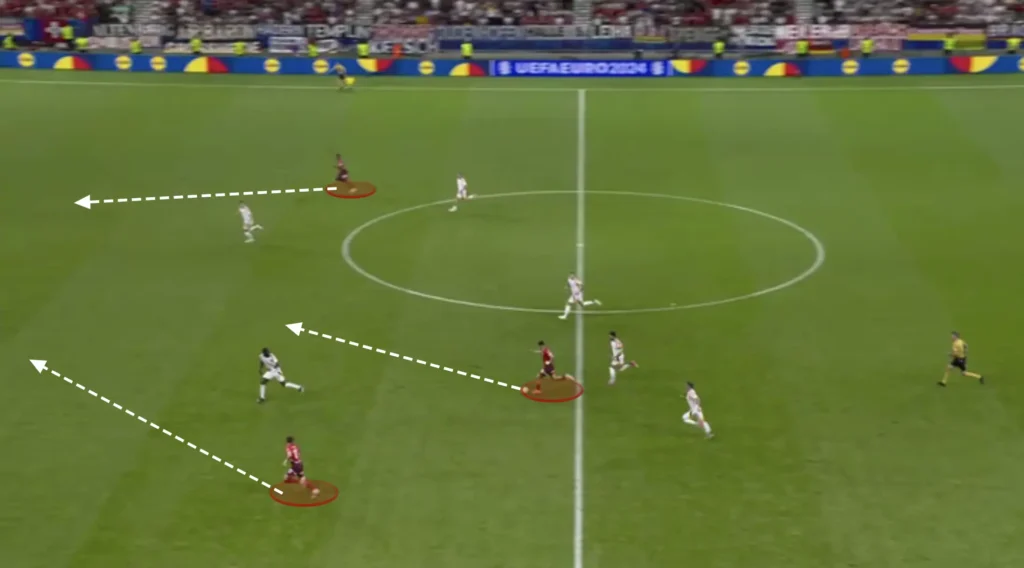In this article, we dive into a tactical analysis of the Swiss national team under the guidance of head coach Murat Yakin. Since taking the helm, Yakin has implemented strategies and formations that reflect his footballing philosophy, shaping Switzerland into a formidable side. We’ll explore the key tactics employed by Yakin, including his approach to both attacking and defensive play, as well as the individual roles of key players. Join us as we dissect the tactical nuances that define Murat Yakin’s Switzerland and understand how these elements come together on the field.
Build-up
Low Build-up
In the low build-up, Yakin sets his team up in a 1-4-3-3 formation, with a back four, one number-six, two number-eights, and three up front.


The number-eights often drop in the low build-up, trying to create numerical advantages, allowing Switzerland to play through the press.
High Build-up
In the high build-up, Yakin changes the formation to a 1-3-2-2-3/1-3-2-5 formation, with a back three, two holding midfielders, two attacking midfielders, and three up front.


The two holding midfielders are rarely positioned in the same line. One will always be a little deeper, but who it is depends on where the ball is.

This allows the holding midfielders to play between themselves and opens up more potential passing combinations. They can also use one touch to play to the other midfielder instead of having to turn and use two or more.


Having four central midfielders(two holding and two attacking) creates more options in the center and less space between the players. Yakin likes this because he prioritizes playing through the middle. He needs one player high and wide to pull apart the backline while the rest create numerical advantages in the midfield areas. This builds good conditions in defensive transitions, allowing more players to press when they lose the ball. Another purpose for keeping many players in the middle is to shorten the distance between them. This shortens the length of the passes, which naturally shortens the time between passes. This means the opposition players will have less time to push up and press, giving the Switzerland players more time and control.
Inverting Aebischer
An interesting detail about Yakin’s playing style is that he inverts the left wingback Michel Aebischer into the midfield during the build-up. Aebischer plays as a left wingback in a back five when Switzerland are out of possession;

But plays as an attacking midfielder when Switzerland are in possession:

This shows Yakin’s commitment to using each player in their best position and utilizing their biggest strengths. In football, leveraging a player’s strengths is crucial for maximizing team performance and achieving success on the pitch. Each player possesses unique skills and attributes, whether it be speed, technical ability, vision, or defensive prowess. By understanding and utilizing these strengths, coaches can design tactics and strategies that play to the team’s collective advantage. Aebischer is better in the middle when attacking and, therefore, inverts during the build-up.
Rotations and Fluidity
Switzerland’s fluidity in the build-up is a defining feature of their tactical approach, emphasizing dynamic player movement and positional interchange. Swiss players frequently rotate positions in the build-up phase, creating unpredictability and making it difficult for opponents to press effectively. The midfielders often drop deep to collect the ball, while center-backs push higher up the flanks, and wingers come in, providing multiple passing options. When an attacking midfielder drops, an opposition midfielder often follows, which opens space in the midfield for the holding midfielder to run into.


Another common pattern in Switzerland’s build-up is when the attacking midfielder and winger switch positions. The winger will make a run toward the middle, which the opposition fullback will follow. This opens the space out wide, allowing the attacking midfielder to drop out into this space and receive the ball.

This fluidity helps maintain possession and progress the ball smoothly through the thirds, enabling Switzerland to exploit spaces in the opposition’s setup.
High Backline (Off)
A massive aspect of Yakin’s high possession build-up is they keep a high backline. This helps in the counterpress because they get closer to the center. Having more players close to the center who can win the ball back makes it difficult for the opposition to do anything when they win possession. Furthermore, the high backline shortens the distance between players, shortening the time and length of the passes and preventing the opposition from pushing up their defense.

Xhaka Dropping
When playing against a front three, Murat Yakin often drops one of the holding midfielders, usually Xhaka into the backline, creating a back four. This creates a 4v3 with the backline against the opposition’s forwards instead of a 3v3, which means that one defender will be free. This allows them to use the extra player to beat the opposition’s forward line and progress the ball.

Linking with the Striker
Yakin, as established, likes to create central overloads when attacking the opposition. Therefore, the Swiss striker often drops during the build-up. When the striker drops, they unlock more ways of beating the opponent’s defense. They can pass the ball to the striker, who can find an attacking midfielder in the pocket or play a one-touch pass out to the winger.
The Swiss players will open the pass from the center-backs to the striker by pulling apart the opposition midfield. The two holding midfielders, Xhaka and Freuler will start close together and move away from each other when a center-back is ready to play the pass to the striker. The opposition midfielders will follow Xhaka and Freuler’s movements, which allows the center-back to pass the ball with control to the dropping striker.

Numerical Advantages
Another massive aspect of Switzerland’s high build-up is their ability to create numerical advantages against the opposition’s defensive line. Their front five naturally becomes numerically superior against a back four, which they are great at taking advantage of.

They mainly exploit this by creating 2v1 situations against the opposition fullback. When the defending team is positioned on one side, the weak-side fullback becomes vulnerable to the long switch of play due to the 1v2 against Switzerland’s winger and attacking midfielder. The attacking midfielder will make a run in behind, the fullback will follow that run, and the space for the winger out wide will be opened. Yakin’s team often capitalizes on this by getting the ball to the winger and creating many opportunities from 2v1 situations on the wing and in the half-spaces.

Final Third
Attacking the Half-Space
Yakin’s teams usually look to create chances by attacking the space between the opposition center-back and fullback. They primarily do this from the wide areas with underlaps from the attacking midfielders. When the winger receives the ball he will attract the opposition fullback. This opens the space between the fullback and the center-back, which allows the Swiss attacking midfielder to make the underlapping run into this space. The ball can be played to the underlapping player, who can cross the ball into the box or attack his defender in a 1v1 situation.


The winger does not have to play the ball to the underlapping player. The run from the attacking midfielder will often drag away an opposition defensive midfielder, which opens the space inside. The winger can take the ball inside and shoot or find a pass to a free player in front of the backline.
Many Players in the Box
The attacking midfielders and wingers look to make runs into the box when the ball is in the final third, often getting four or five players into these areas to create overloads. The numerical advantages in the box force the defending team to make decisions and leave some players open.


Yakin also positions many players outside the box, ready for the second balls and cut-backs. They always succeed in pushing down the opposition’s defense, which opens the space in front of the backline. The midfielders will often be found in these spaces with cut-backs, and from there, they can shoot or combine with an attacker to create goalscoring opportunities.

Defending
High Press
Murat Yakin places much value on being aggressive without the ball. This shows in Switzerland’s high pressure. Yakin usually wants his team to go man-to-man and intensely press the opposition. Each player is assigned a direct opponent to mark tightly, ensuring no easy passing options are available. This intense pressure forces the opposing team into hurried decisions, often resulting in turnovers in dangerous areas. Switzerland almost use their high press as an attacking threat, scoring many goals from winning the ball high up the pitch.


In a man-to-man system, it becomes crucial that the players know when to mark the opponent they are responsible for and when not to. If an opponent, for example, is very far from the ball, the Swiss player marking him does not need to be as close to him. He can instead come in and help create numerical superiorities in the center, decreasing the risk of dangerous 1v1 situations. The Swiss players will always have an opposition player they are responsible for, however, they will never be closer to them than they need to be.
Here, the Swiss players on the other side from where the ball is have come in, creating numerical superiorities in the midfield. They are, however, close enough to their opponent to scare the ball-holder away from passing the ball to them.

Low Press
Yakin’s Switzerland uses a 1-5-4-1 formation in the low press. They look to set up in a mid-block, always trying to close the center, forcing the opposition out wide. Yakin wants his team to stay compact without dropping too low, preferably closing the space between the midfield and backline.


High Backline (Def)
One tool that helps to be compact is to play with a high backline, making the space to the midfield line as small as possible. Switzerland do this and usually try to keep the highest line they can without leaving the space behind them too open. Defending with a high backline involves positioning the defensive line closer to the midfield, rather than near the goalkeeper. This tactic compresses the space available for the opposing team to operate, disrupting their build-up play and increasing the chances of winning the ball back quickly.

A high backline also allows defenders to support the midfield more effectively, creating numerical superiority in central areas and facilitating quicker transitions from defense to attack. However, it requires defenders with good pace and positional awareness to deal with long balls and prevent opposing attackers from exploiting the space behind. This approach demands constant communication and coordination among the backline to maintain a cohesive and effective defensive structure.
Everyone must be in the same line when defending with a high backline to maintain an effective offside trap, ensure cohesive coverage, and reduce gaps that attackers can exploit. A well-aligned defensive line makes it easier to catch opposing forwards offside, preventing them from receiving the ball in dangerous positions.
Squeezing the Pitch
Yakin always wants his team to squeeze the pitch when defending. This means constantly pushing the team up as much as possible. Every time the opponent plays a slow, sideways pass or a back pass, Switzerland’s first line of pressure pushes up, with the rest of the team following to stay compact. When the next pass comes, they push up even more, forcing the opponent back even more. They do this because it pushes the opponent further away from the Swiss goal, making it harder to create chances.


Aggressive Center-backs
Another aspect of Switzerland’s low press that makes them difficult to break down is their aggressive wide center-backs. Rodriguez and Schär are never afraid to push up on an opposition midfielder to stop them from turning and driving with the ball. This forces the opposition back while giving the Swiss midfielders and attackers more freedom to push up and press when defending. The problem with pushing up a center-back is that big spaces get created between the defenders. Yakin’s players are, however, great at solving this. The backline will quickly become a compact back four, with the defenders coming across to close the space that the pushing center-back opened.

Transitions
Defensive Transitions
Positioning many players centrally, creating a numerical advantage in the midfield, creates good conditions in defensive transitions. Many players close to the ball after losing possession means that many players can work towards regaining possession. Yakin’s players are also very aggressive in the first seconds after losing the ball. The four or five players closest will immediately jump on the opposition player with the ball and close the distance to cut off any passing lanes. Switzerland, therefore, often regain possession directly after losing it.

Offensive Transitions
Yakin also wants his team to counterattack in their offensive transitions. The first thought is always to play forward when they win the ball. Switzerland look to counterattack with a high tempo, often attacking the spaces between the center-backs and fullbacks. In addition, keeping many players centrally while defending enables them to incorporate more players into the counterattacks.


Final Thoughts
In conclusion, Murat Yakin’s tactical approach with Switzerland showcases a blend of defensive solidity and attacking ingenuity. His emphasis on a well-structured defense, combined with flexible attacking strategies, has allowed Switzerland to compete effectively on the international stage. Yakin’s ability to adapt formations and exploit the strengths of his players has been pivotal in crafting a cohesive and resilient team.
Switzerland’s performances under Yakin highlight a team capable of executing a sophisticated game plan while remaining adaptable to different opponents. As the team continues to develop under his guidance, the tactical foundations laid by Yakin will be crucial in their quest for success in future tournaments. The strategic insights and disciplined approach reflected in this analysis underscore the promising direction in which Switzerland is heading under Murat Yakin’s leadership.
